UN World Water Development Report 2025 – Mountains and Glaciers
Syllabus: GS 3/Environment, Conservation
Key Findings
Accelerated Glacier Melt:
- Glaciers are melting at an unprecedented rate, with significant mass loss in recent years.
- Over 9,000 billion tonnes of ice have been lost since 1975—equivalent to an ice block the size of Germany.
- Impurities like black carbon from wildfires and dust storms are intensifying the melting process by absorbing more solar radiation.
Permafrost Thawing:
- Rising temperatures are causing permafrost to melt, releasing organic carbon into the atmosphere and worsening climate change.
- Destabilized slopes increase the risk of landslides and other natural disasters.
Decline in Snow Cover:
- Snow cover in mountain regions has decreased, particularly during spring and summer.
- Between 1979 and 2022, there has been a 79% global decline in snow cover.
Impacts & Concerns
Erratic Water Flow & Flooding Risks:
- Increased risk of Glacial Lake Outburst Floods (GLOFs)—responsible for over 12,000 deaths in the past 200 years.
Sea Level Rise Contribution:
- Glacier melt accounts for 25-30% of global sea level rise, threatening millions worldwide.
Way Forward & Recommendations
Mountains as Water Towers:
- Covering 33 million sq km, mountain regions sustain nearly 2 billion people by providing freshwater.
Policy & Awareness:
- Urgent need for resource mobilization and strong policy frameworks to mitigate climate impacts.
- Increased awareness and proactive action required to protect mountain ecosystems and downstream communities.
With reference to the United Nations World Water Development Report 2025, consider the following statements:
- The report states that glaciers have lost over 9,000 billion tonnes of ice since 1950.
- Black carbon from wildfires and dust storms can accelerate glacier melting by increasing solar radiation absorption.
- The report highlights that permafrost thawing is reducing atmospheric carbon levels, thereby mitigating climate change.
Which of the statements given above is/are correct?
(a) 1 and 2 only
(b) 2 only
(c) 1 and 3 only
(d) 1, 2, and 3
Answer: (b) 2 only
Explanation:
Statement 1 is incorrect: The report highlights that glaciers have lost over 9,000 billion tonnes of ice since 1975, not 1950.
Statement 2 is correct: Black carbon and dust can accelerate glacier melting by increasing the absorption of solar radiation.
Statement 3 is incorrect: Permafrost thawing releases organic carbon into the atmosphere, exacerbating climate change rather than mitigating it.
Shaheed Diwas
Syllabus: GS1/History
Context:
- On March 23, the nation pays tribute to Bhagat Singh, Rajguru, and Sukhdev on Shaheed Diwas, commemorating their execution in 1931. Their sacrifice remains a powerful symbol of India’s freedom struggle.
Background:
- In 1928, the British government sent the Simon Commission, an all-British panel, to India to discuss constitutional reforms. This led to widespread protests as it excluded Indian representation.
- Lala Lajpat Rai led a protest in Lahore, where police, under Superintendent James A. Scott, brutally lathi-charged the demonstrators. Lajpat Rai succumbed to his injuries on November 17, 1928.
- To avenge his death, Bhagat Singh, Rajguru, and Sukhdev targeted James Scott but mistakenly killed British officer John Saunders
- Arrested, tried, and sentenced to death, they became martyrs for India’s independence movement. Their execution inspired countless revolutionaries to continue the struggle for freedom.
Revolutionary Legacy:
- Bhagat Singh (1907–1931), Sukhdev (1907–1931), and Rajguru (1908–1931) were key members of the Hindustan Socialist Republican Association (HSRA), a revolutionary group committed to armed resistance against British rule.
- Bhagat Singh was deeply influenced by Marxist and anarchist ideologies, drawing inspiration from Karl Marx, Vladimir Lenin, and Leon Trotsky.
- He is also remembered for the 1929 bombing of the Central Legislative Assembly in Delhi, aimed at protesting against oppressive laws, without intending to cause harm.
- Shaheed Diwas serves as a reminder of their unwavering courage, patriotism, and ultimate sacrifice in the fight for India’s independence.
Consider the following statements regarding the Simon Commission and its impact on the Indian freedom struggle:
- The Simon Commission was sent by the British government in 1927 to assess the need for constitutional reforms in India.
- The commission did not include any Indian members, leading to widespread protests across the country.
- Lala Lajpat Rai was fatally injured during a protest against the Simon Commission in Kolkata.
Which of the statements given above is/are correct?
a) 1 and 2 only
b) 2 and 3 only
c) 1 and 3 only
d) 1, 2, and 3
Answer: a) 1 and 2 only
Explanation:
- The Simon Commission was sent in 1928, not 1927.
- The absence of Indian representation led to widespread protests.
- Lala Lajpat Rai was injured in a protest in Lahore, not Kolkata.
Tavasya
Syllabus: GS3/Defence
Overview
- Tavasya, the second frigate under Project 1135.6 Additional Follow-on Ships, was launched by Goa Shipyard Limited (GSL).
- This follows the launch of Triput in 2024, with both frigates expected to be delivered to the Indian Navy by 2026 and 2027.

Background
- In 2016, India and Russia signed an agreement for four additional Krivak-class stealth frigates.
- Two were imported from Russia, while two were built in India under technology transfer.
- Tavasya is the second of the two indigenously built follow-on Krivak-class frigates.
Key Features
- Symbolism: Named after Bhima’s mace, representing naval strength.
- Multi-Role Capability: Designed for surface, sub-surface, and air combat operations.
- Specifications:
- Length: 124.8 meters
- Width: 15.2 meters
- Draught: 4.5 meters
- Displacement: ~3,600 tonnes
- Speed: Maximum 28 knots
Indigenous Contributions
- Triput and Tavasya incorporate indigenous equipment, weapons, and sensors, enhancing India’s naval self-reliance.
- Tavasya marks a significant milestone, likely signaling the end of license-built warships as India advances toward self-designed and self-constructed naval vessels.
With reference to India’s Project 1135.6, consider the following statements:
- The project involves the construction of four additional Krivak-class frigates, two of which were built in India under a technology transfer agreement.
- The Krivak-class frigates are primarily designed for amphibious assault operations.
- Tavasya is the first of the two follow-on stealth frigates built by Goa Shipyard Limited under this project.
Which of the statements given above is/are correct?
(a) 1 only
(b) 1 and 3 only
(c) 2 and 3 only
(d) 1, 2, and 3
Answer: (a) 1 only
Explanation:
- Statement 1 is correct. India signed an agreement with Russia in 2016 for four additional Krivak-class stealth frigates, with two built in Russia and two in India under technology transfer.
- Statement 2 is incorrect. Krivak-class frigates are designed for anti-surface, anti-submarine, and anti-air warfare, not amphibious assault operations.
- Statement 3 is incorrect. Tavasya is the second of the two follow-on stealth frigates built by Goa Shipyard Limited (GSL) under this project, not the first.
Anthurium Flowers
Syllabus: GS3/ Environment
In News
- Mizoram marked a significant milestone in agro-based exports from the North Eastern Region (NER) by exporting its first consignment of Anthurium flowers to Singapore.
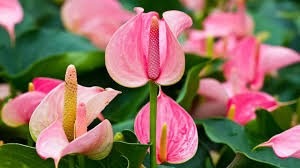
About Anthurium Flowers
- Scientific Name: Anthurium
- Geographical Distribution:
- Native to the Americas, spanning from northern Mexico to northern Argentina, including the Caribbean.
- In India, it thrives in the Northeastern states, particularly Mizoram, due to its favorable climate.
- Other key cultivation regions include Tamil Nadu (21%), Karnataka (16%), Madhya Pradesh (14%), and West Bengal (12%).
Botanical & Morphological Features
- A herbaceous plant that grows as an epiphyte (on other plants) or terrestrially.
- Recognized by its spadix (central spike) and a colorful spathe (leaf-like bract) in shades of red, pink, orange, and more.
- Contains calcium oxalate crystals, making its sap an irritant to skin and eyes.
Economic & Cultural Significance
Exports:
- Contributes to India’s floriculture exports, valued at USD 86.62 million in FY 2023–24.
- Major importers include the USA, Netherlands, UAE, UK, and Canada.
Tourism & Cultural Promotion:
- Mizoram hosts the annual “Anthurium Festival”, which promotes tourism, local enterprises, and the commercial value of the flower.
Livelihood Support:
- A crucial source of rural income, particularly benefiting women farmers and cooperative societies in the Northeast.
Consider the following statements regarding Anthurium flowers:
- Anthurium is a species native to Southeast Asia and is widely cultivated in the Indian subcontinent.
- In India, Mizoram is the leading producer of Anthurium flowers due to its suitable climatic conditions.
- Anthurium plants grow exclusively as terrestrial plants and do not exhibit epiphytic characteristics.
- The sap of Anthurium contains calcium oxalate crystals, which can be an irritant to human skin and eyes.
Which of the above statements is/are correct?
(a) 1 and 3 only
(b) 2 and 4 only
(c) 1, 2, and 3 only
(d) 2, 3, and 4 only
Answer: (b) 2 and 4 only
Explanation:
Statement 1 is incorrect – Anthurium is native to the Americas (from northern Mexico to northern Argentina), not Southeast Asia.
Statement 2 is correct – Mizoram is a major cultivator of Anthurium in India, supported by its favorable climatic conditions.
Statement 3 is incorrect – Anthurium plants can grow both terrestrially and epiphytically.
Statement 4 is correct – The plant contains calcium oxalate crystals, which can cause skin and eye irritation.
Eucalyptus
Syllabus: GS3/Environment
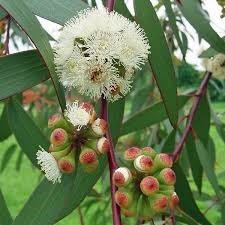
Background
- Eucalyptus, a fast-growing tree native to Australia, was introduced to India by the British in the 1840s for timber production.
- In Karnataka, large-scale eucalyptus plantations were established between the 1960s and 1980s to support the timber and paper industries.
- However, environmental concerns led to a ban on eucalyptus cultivation in 2017, though a 2019 court stay temporarily halted its enforcement.
Environmental Concerns
- Groundwater Depletion – Eucalyptus has a high water demand, which disrupts local hydrological cycles and depletes groundwater levels.
- Soil Degradation & Loss of Biodiversity – The tree exhibits allelopathy (chemical suppression of other plant growth), reducing soil fertility and harming native vegetation.
- Impact on Grassland Ecosystems – Large-scale plantations encroach upon natural grasslands, threatening species such as:
- Blackbucks (Antilope cervicapra)
- Lesser Floricans (Sypheotides indicus)
- Great Indian Bustards (Ardeotis nigriceps)
Future Outlook
- Grasslands and savannah ecosystems play a crucial role in biodiversity conservation and rural livelihoods.
- Karnataka aims to balance economic development with environmental sustainability, serving as a model for sustainable ecological practices in India.
Consider the following statements regarding Eucalyptus cultivation in Karnataka:
- The British introduced eucalyptus to India in the 19th century primarily for its medicinal properties.
- Karnataka banned eucalyptus plantations in 2017 due to their adverse environmental effects.
- Eucalyptus trees contribute significantly to groundwater recharge due to their deep-rooted structure.
- Eucalyptus exhibits allelopathy, which negatively impacts soil fertility and biodiversity.
Which of the statements given above are correct?
(a) 1 and 3 only
(b) 2 and 4 only
(c) 1, 2, and 4 only
(d) 1, 3, and 4 only
Answer: (b) 2 and 4 only
Explanation:
Statement 1 is incorrect – The British introduced eucalyptus in the 1840s for timber production, not for medicinal purposes.
Statement 2 is correct – Karnataka banned eucalyptus cultivation in 2017 due to environmental concerns.
Statement 3 is incorrect – Eucalyptus is known for high water consumption rather than contributing to groundwater recharge.
Statement 4 is correct – The tree releases chemical compounds that inhibit the growth of other plants (allelopathy), reducing soil fertility and biodiversity.
Lapis Lazuli
Syllabus :GS1/Geography /GS3/Economy
Overview
- Lapis Lazuli is a highly valued semi-precious rock known for its deep blue color, often streaked with golden flecks.
Composition
- The intense blue hue of lapis lazuli is due to lazurite (25-40%), with its shade influenced by sulfur content.
- The golden shimmer comes from the presence of pyrite, while diopside and sodalite occur in minor quantities.
Global Distribution
- Found in several countries, including Chile, Russia, and the United States.
- The finest quality lapis lazuli originates from Badakhshan province in Afghanistan, where it has been mined for over 6,000 years.
Historical Significance
- Ancient India: Lapis lazuli was imported from Badakhshan as early as 1000 BCE.
- Indus Valley Civilization: Archaeologists have discovered lapis lazuli ornaments in sites like Mohenjo-daro and Harappa.
- Ancient Egypt: Used extensively in jewelry and ground into powder for eye makeup.
- Renaissance Europe: Artists ground lapis lazuli into ultramarine pigment, which was one of the most expensive colors used in paintings.
- Lapis lazuli remains a gemstone of historical, artistic, and cultural significance, valued for both its beauty and its enduring legacy.
With reference to Lapis Lazuli, consider the following statements:
- It derives its blue color primarily from the presence of the mineral azurite.
- Pyrite inclusions in lapis lazuli are responsible for its characteristic golden specks.
- The Indus Valley Civilization had no known trade connections for acquiring lapis lazuli.
- The Badakhshan region in Afghanistan is historically known for high-quality lapis lazuli deposits.
Which of the statements given above are correct?
(a) 1 and 3 only
(b) 2 and 4 only
(c) 1, 2, and 4 only
(d) 1, 3, and 4 only
Answer: (b) 2 and 4 only
Explanation:
Statement 1 is incorrect – The blue color of lapis lazuli comes from lazurite, not azurite.
Statement 2 is correct – The golden specks in lapis lazuli are due to pyrite inclusions.
Statement 3 is incorrect – The Indus Valley Civilization did trade for lapis lazuli, as evidenced by findings in Mohenjo-daro and Harappa.
Statement 4 is correct – Badakhshan (Afghanistan) has been a primary source of high-quality lapis lazuli for over 6,000 years.
Sukhna Wildlife Sanctuary
Syllabus:Environment
Context:
- The Punjab government recently informed the Supreme Court (SC) that the Eco-Sensitive Zone (ESZ) around Sukhna Wildlife Sanctuary would be limited to 100 meters for the Nayagaon municipal committee instead of the previously proposed 1 to 3 km.
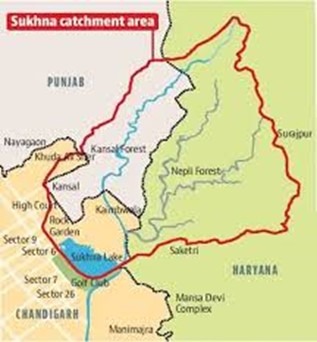
About Sukhna Wildlife Sanctuary:
- Location: Situated in Chandigarh, near the renowned Sukhna Lake, at the foothills of the Shivalik range.
- Origin of Sukhna Lake:
- Created in 1958 by the famous architect Le Corbusier.
- Formed by diverting the Sukhna Choe, a seasonal stream originating from the Shivalik hills.
Establishment:
- The sanctuary was officially notified in 1998.
- Developed as part of afforestation efforts for soil conservation around Sukhna Lake.
- Geography & Soil Characteristics:
- Covers 2,600 hectares.
- Comprises sandy soil from the Shivalik hills, interspersed with clay pockets.
- Geographically unstable and prone to soil erosion, particularly during the monsoon season.
- The sanctuary has around 150 small and large water bodies, including Sukhna Lake, forming its catchment area.
Ecological Features:
- Vegetation & Ecosystem
- The sanctuary comprises a mosaic of forests, grasslands, and wetlands, with Sukhna Lake serving as a vital component of its ecosystem.
- Flora
Notable tree species:
- Khair (Acacia catechu)
- Phulai (Acacia modesta)
- Kikar (Acacia nilotica)
- Shisham (Dalbergia sissoo)
Other species:
- Moonj (Saccharum munja) – A grass species.
- Amaltas (Cassia fistula) – Indian Laburnum with medicinal and ornamental value.
- Jhingan (Lannea coromandelica) – Used in traditional medicine.
- Amla (Phyllanthus emblica) – Indian Gooseberry.
- Rati, Vasaka – Medicinal plants contributing to the region’s biodiversity.
- Fauna
Mammals:
- Squirrel
- Common Mongoose
- Indian Hare
- Porcupine
- Jungle Cat
- Jackal
- Wild Boar
- Avian Diversity:
- Peacock
- Hill Myna
- Jungle Crow
- Black Drongo
- Parrots
- Doves
- Seasonal migratory birds also visit the sanctuary.
Significance & Concerns:
Eco-Sensitive Zone (ESZ) Reduction:
- The Punjab government’s decision to limit the ESZ to 100 meters in Nayagaon raises concerns about urban encroachment and its impact on the sanctuary’s ecosystem.
- Originally, an ESZ of 1 to 3 km was proposed to buffer the sanctuary from human activities.
Environmental Challenges:
- Soil erosion and runoff threaten the stability of the area.
- Increasing urbanization and deforestation pose risks to water bodies and wildlife habitats.
Conservation Outlook:
- Need for balanced urban planning while ensuring habitat protection.
- Strengthening afforestation and soil conservation measures to maintain ecological integrity.
- The Sukhna Wildlife Sanctuary plays a critical role in maintaining regional biodiversity, and decisions regarding its Eco-Sensitive Zone should prioritize long-term environmental sustainability over short-term urban expansion.
With reference to the Sukhna Wildlife Sanctuary, consider the following statements:
- It was established in 1958 as a protected area for wetland conservation.
- The sanctuary is located at the foothills of the Shivalik range and is prone to soil erosion.
- Sukhna Lake was artificially created by diverting a seasonal stream.
Which of the statements given above is/are correct?
(a) 1 and 2 only
(b) 2 and 3 only
(c) 1 and 3 only
(d) 1, 2, and 3
Answer: (b) 2 and 3 only
Explanation:
- The sanctuary was established in 1998, not 1958 (Statement 1 is incorrect).
- It is located in the Shivalik foothills, prone to soil erosion (Statement 2 is correct).
- Sukhna Lake was artificially created in 1958 by diverting Sukhna Choe, a seasonal stream (Statement 3 is correct).
Strait of Hormuz
Syllabus:Georaphy
Latest News
- Amid escalating tensions with the United States, Iran has deployed missile systems on the three disputed islands—Greater Tunb, Lesser Tunb, and Abu Musa—located near the Strait of Hormuz.
- This move highlights Iran’s strategic control over this critical maritime passage and raises concerns over regional security and global energy supply disruptions.
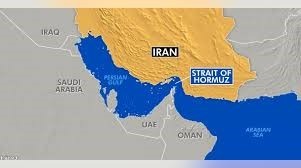
Key Facts About the Strait of Hormuz
Geographical Significance:
- The Strait of Hormuz is a narrow yet strategically vital waterway that lies between Iran and the Arabian Peninsula, specifically the United Arab Emirates (UAE) and Oman’s Musandam Peninsula.
- It serves as a critical maritime route connecting the Persian Gulf to the Gulf of Oman and further to the Arabian Sea and the Indian Ocean.
Geopolitical Boundaries:
- Northern Coast: Iran
- Southern Coast: United Arab Emirates (UAE) and Oman
- Western End: Persian Gulf
- Eastern End: Gulf of Oman
- Dimensions & Navigability:
- The Strait of Hormuz stretches for 167 kilometers in length.
- The width varies from 95 kilometers at its broadest point to just 39 kilometers at its narrowest.
- Despite its narrowing towards the north, it remains deep enough for the passage of large oil tankers and cargo vessels.
Islands in the Strait of Hormuz:
- Hengam Island
- Hormuz Island
- Qishm Island
- Greater Tunb, Lesser Tunb, and Abu Musa (disputed between Iran and UAE)
Economic & Strategic Importance:
- It is one of the world’s most critical choke points for global energy trade.
- Approximately 25% of the world’s crude oil and 30% of the world’s liquefied natural gas (LNG) pass through this waterway.
- Disruptions in the Strait of Hormuz can significantly impact global oil prices and energy security.
Consider the following statements regarding the Strait of Hormuz:
- It connects the Persian Gulf to the Arabian Sea.
- It is the narrowest maritime chokepoint for global oil transportation.
- The United States maintains a permanent naval base on Abu Musa Island to secure energy trade.
Which of the statements given above is/are correct?
(a) 1 and 2 only
(b) 2 and 3 only
(c) 1 and 3 only
(d) 1, 2, and 3
Answer: (a) 1 and 2 only
Explanation:
- Statement 1 is correct: The Strait of Hormuz connects the Persian Gulf to the Gulf of Oman, which in turn leads to the Arabian Sea.
- Statement 2 is correct: It is one of the narrowest and most critical maritime chokepoints for global oil transportation, with a width narrowing to 39 km at its tightest point.
- Statement 3 is incorrect: The United States does not maintain a permanent naval base on Abu Musa Island. The island is disputed between Iran and the UAE, and Iran has control over it. The S. does, however, maintain a strong naval presence in the region through its 5th Fleet, headquartered in Bahrain.
Urban Heat Island (UHI)
Syllabus:Environment
- The Telangana Socio-Economic Outlook 2025 report highlights that Hyderabad is experiencing intensified nighttime heat stress due to the Urban Heat Island (UHI) effect.
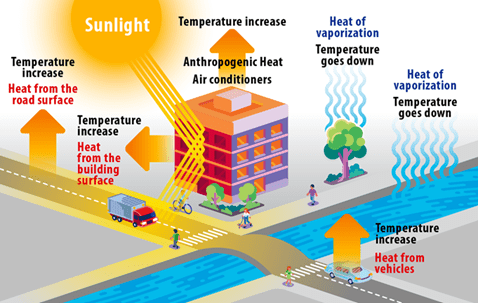
Understanding the Urban Heat Island Effect
- The Urban Heat Island (UHI) effect is a climatic phenomenon where urban areas experience significantly higher temperatures compared to their surrounding rural regions. This temperature disparity is primarily driven by human activities and urban development that modify land surfaces and atmospheric conditions.
Key Causes of the UHI Effect:
- Loss of Green Spaces & Natural Soils
- Urbanization reduces vegetation cover (trees, parks, and grasslands), leading to diminished shading and evapotranspiration, a natural cooling process.
- Building & Infrastructure Density
- Materials like concrete, asphalt, and metal absorb and store more heat than natural surfaces, retaining warmth for longer durations.
Urban Layout & Street Design
- Narrow streets and high-rise buildings create “urban canyons” where heat is trapped and less effectively dissipated, exacerbating localized warming.
- Heat Emissions from Human Activities
- Vehicles, air conditioners, industrial operations, and power generation contribute to increased heat output.
- Greenhouse gases (e.g., CO₂) trap this heat, further amplifying the warming effect.
Consequences of the UHI Effect:
- Increased nighttime temperatures—urban areas cool down more slowly than rural surroundings.
- Temperature differentials can reach up to 12°C at night, intensifying heat stress and impacting public health.
- Exacerbates global warming, making cities even hotter.
Why is it Called an “Urban Heat Island”?
- The term originates from temperature distribution maps, where urban zones appear as “hot islands” amid cooler rural surroundings, resembling an island of heat in a “sea” of lower temperatures.
- The UHI effect, when combined with climate change, contributes to rising global temperatures and urban microclimates, making sustainable urban planning crucial for mitigating heat stress in cities.
Consider the following statements regarding the Urban Heat Island (UHI) effect:
- It is caused solely by industrial emissions and vehicular pollution.
- Urban areas tend to remain warmer than rural areas, especially at night.
- The phenomenon is exclusive to tropical and subtropical cities.
- Evapotranspiration plays a crucial role in mitigating UHI effects.
Which of the statements given above are correct?
(a) 1 and 3 only
(b) 2 and 4 only
(c) 1, 2, and 4 only
(d) 1, 2, 3, and 4
Answer: (b) 2 and 4 only
Explanation:
- Statement 1 is incorrect: UHI is caused by multiple factors including reduced green cover, heat-retaining infrastructure, and human activities like air conditioning, industrial emissions, and vehicular heat emissions. It is not solely due to pollution.
- Statement 2 is correct: Urban areas absorb and retain heat during the day and release it slowly at night, leading to higher nighttime temperatures compared to rural areas.
- Statement 3 is incorrect: UHI is not limited to tropical regions; it can occur in temperate, arid, and even cold regions, depending on urbanization patterns.
- Statement 4 is correct: Evapotranspiration (moisture loss from plants and soil) cools the air, helping to mitigate UHI intensity.
Gujarat Achieves 95% of NITI Aayog’s TB-Free Target
Syllabus:Health

Key Achievements
- Gujarat was assigned a target of 145,000 TB patient registrations and successfully registered 137,929 cases.
- A total of 124,581 patients completed treatment, achieving a 90.52% treatment completion rate.
- Treatment facilities were provided to 131,501 registered TB patients.
- Financial Assistance – Nikshay Poshan Yojana (NPY)
- Each notified TB patient receives ₹1,000 per month during treatment.
- Assistance is provided in cash or in-kind to ease the financial burden.
Nutritional Support Initiatives
- A total of 10,682 Nikshay Mitras have been registered on the Nikshay portal.
- A total of 349,534 nutrition kits have been distributed to TB patients to ensure proper dietary support.
100-Day Intensive TB Eradication Campaign
- Launched in December 2024 to enhance early detection and treatment.
- Covers 16 districts and four municipal corporations.
- As of March 20, 2025, 35.75 lakh individuals have been screened, leading to the detection of 16,758 new TB patients.
Conclusion
Gujarat’s initiatives in early detection, financial support, and nutritional assistance are significantly contributing to TB elimination.
Consider the following statements regarding the Nikshay Poshan Yojana (NPY):
- It provides direct financial assistance to tuberculosis (TB) patients for their nutritional support.
- The financial assistance under the scheme is ₹500 per month for every TB patient.
- It is part of the National Tuberculosis Elimination Program (NTEP).
Which of the statements given above is/are correct?
(A) 1 and 2 only
(B) 1 and 3 only
(C) 2 and 3 only
(D) 1, 2, and 3
Answer: (B) 1 and 3 onlyExplanation:
- Statement 1 is correct: The Nikshay Poshan Yojana (NPY) provides financial assistance to TB patients to help meet their nutritional requirements.
- Statement 2 is incorrect: The financial assistance provided is ₹1,000 per month, not ₹500.
- Statement 3 is correct: The scheme is part of the National Tuberculosis Elimination Program (NTEP).
